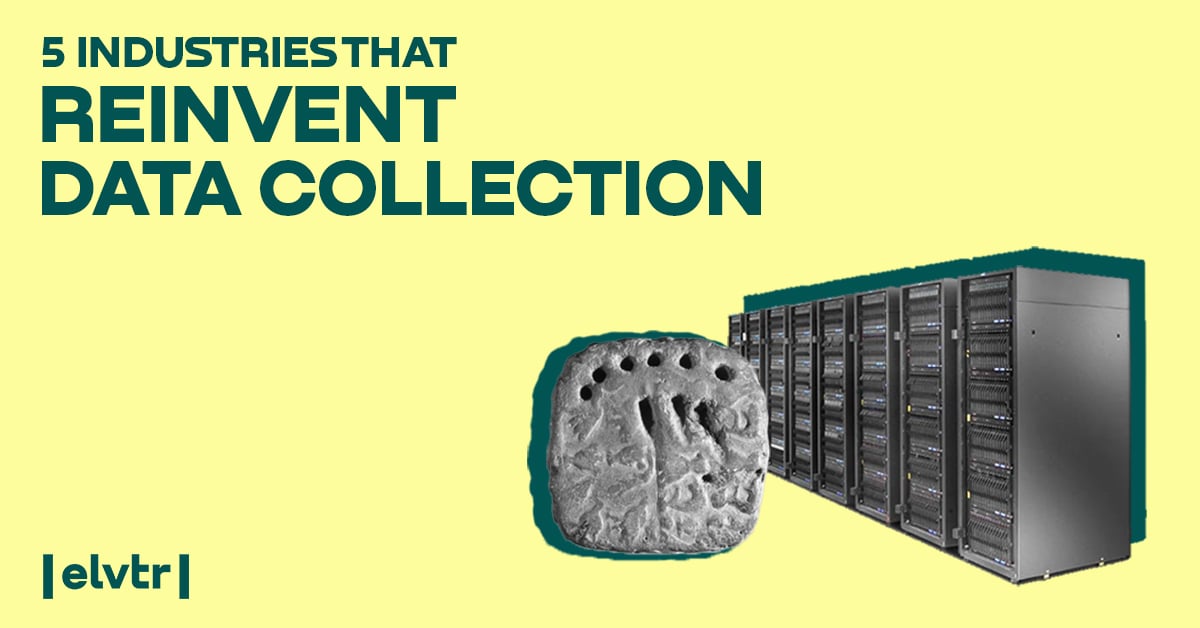- MAIN PAGE
- – elvtr magazine – 5 INDUSTRIES THAT REINVENT DATA COLLECTION
5 INDUSTRIES THAT REINVENT DATA COLLECTION

People have been relying on data for a really long time. The oldest proof we can get is Mesopotamian accounting, used to track growth of crops and animal count. A couple of thousands years later, we invented Big Data.
At this point, data analytics transform everything from healthcare to telecom and agriculture. However, these are marketers who seem to be most obsessed with data right now. No wonder why.
Collecting data is what it takes to truly understand customers' behavior. And taking your customers’ behavior into account — results in outperforming peers by 85 percent in sales growth, according to Gallup.
We have found at least 5 examples of how other industries reinvent data collection, generating significant improvements.
Further, you’ll discover:
- Types of customer data;
- Most common ways to collect it
- Consequences of poor data gathering
- 5 industries reinventing data collection
- Expert opinion: How will today’s privacy discourse influence the way we collect data?
TYPES OF CUSTOMER DATA
In his interview with BND Liam Hanham, data science manager @ Workday says there are three ways in which customer data can be collected: “by directly asking customers, by indirectly tracking customers, and by appending other sources of customer data to your own.”
"Customer data can be collected in three ways…a robust business strategy needs all three."
LIAM HANHAM /
WORKDAY
Alternatively, if you choose to follow the basic data collection workflow, the following four broad categories turn up:
Personal Data includes both: Personally Identifiable Information (PTI) such as full name, physical address, social security number, race, and gender; as well as Non-Personally Identifiable Information (NPTI) which would include Cookies and Device IDs.
Engagement Data gives us insights into customers’ interactions with a brand and includes metrics like Website Visits, Bounce Rate, and Click-Through-Rates.
Behavioral Data tells us ways in which customers undertake their purchase journeys, so that would include transactional data like Subscriptions and Purchase Details. It also includes product usage (Repeated actions, Feature usage) and qualitative data (scroll, mouse movement).
Attitudinal Data. Customers’ emotions drive attitudinal data. Using that one finds out how a customer feels about a brand. Parameters like Customer Satisfaction and Purchase Criteria would qualify as attitudinal data.
TRADITIONAL DATA COLLECTION METHODS
Questionnaires - a relatively cheap, quick, and efficient way of obtaining a lot of information from a large sample of people.
Interviews are different from questionnaires as they involve social interaction. Unlike questionnaire methods, interviews take much more resources to prepare and require a certain level of a researcher’s competence.
Registration allows companies to collect basic information when users sign up for subscriptions, newsletters, or any type of similar rewards program.
Naturalistic Observation involves studying the spontaneous behavior of participants in natural surroundings. A proper observation can provide a lot of insights into how people actually use the product.
Focus Groups generate qualitative narrative data through the use of open questions. By allowing respondents to talk choosing their own words, the researcher develops a real understanding of peoples' opinions.
CAUTION: POORLY COLLECTED DATA CAUSES INDUSTRY-WIDE HARM.
Inadequately collected data can generate various research issues including:
-
inability to answer your own research questions;
-
failure in repetition and validating a study;
-
making wrong decisions that influence public policy;
-
inflicting harm on research participants;
-
misleading other researchers towards dead ends.
DATA COLLECTION ACROSS INDUSTRIES
Healthcare
Medical records, billing information, health surveys, medicare plans...Just a tiny part of a diverse set of sources used by an average medical establishment.
The challenge is that no setup alone can collect all the data on every patient. Especially in urgent conditions (which are normal throughout the healthcare industry).
Electronic health record (EHR) systems create a comprehensive personal profile, collecting medical data from various sources. Above all, EHRs are able to transfer information to any clinical establishment and hospital. Access to such a unified database provides critical information from a patient’s health history — in a matter of minutes. Some EHR apps can even send notifications if you need to undergo a new test or take their medicine.
Agriculture
In recent times, the agriculture industry has been able to access data that was unimaginable even a decade ago.
McKinsey’s ACRE (an agricultural advanced-analytics center) uses data provided by NASA and the National Oceanic and Atmospheric Administration (NOAA), plus data from private sources to generate precise weather forecasts.
Farmers now can make short-to-long-term decisions with way better outcomes. ACRE’s reports enable us to predict yields two months before harvest. With 96% accuracy!
Insurance
Whether it’s customizing products to individual preferences or reducing fraud, insurers endlessly benefit from big data. The latest leap was the introduction of InsurTech. Now, time-consuming and laborious tasks like underwriting a life insurance application can be done automatically in real-time.
What makes this possible is software that collects data from sources like an applicant’s drug report, their driving records as well as the Medical Information Bureau. The collected data is then compared with answers that consumers provide, thereby precluding the need to manually underwrite insurance.
Retail
While online retailers are ahead of their offline counterparts in targeted marketing, many non-digital retailers are attempting innovative tactics like deploying electronic beacons in their stores.
Target presents a fine example of using these devices to track their customers’ in-door behavior. It is later processed using AI to match personalized promotions, connecting to the app on customers’ smartphones.
Finance
In the face of rising credit card debt, banks and financial institutions have leveraged big data to help their customers pay off their loans. Challenger bank Tandem serves “artificial intelligence-driven highlights” to alert its customers of important updates so they can take control of their expenditures.
Credit card company Petalenables its customers to track their payment records as well. A Petal cardholder can calculate interest rates based on their payment plan.
DATA COLLECTION VS PRIVACY
Director of Analytics at Google, Kevin Hartman — argues that the measurement infrastructure we've been using for decades is now under threat due to the privacy imperative.
"Google's commitment in the next two years is phasing out all cookie usage as well in Chrome. That will hamper advertisers’ ability to measure to target and to create personalized web experiences."
KEVIN HARTMAN /
GOOGLE
What has however been a refreshing find (restoring marketers' hope) is that a McKinsey report, published earlier this year — showed that consumers are beginning to be more open to data management. The respondents concluded that they are more likely to trust a company if they limited their queries about personal information and asked questions about companies’ products.
If these results are to be treated as a precursor to a new era in a consumer’s relationship with privacy, then it is exciting to look forward to the types of innovations big data will drive in the near future.
*ELVTR is disrupting education by putting proven industry leaders in a virtual classroom with eager rising stars. ELVTR courses offer 100% instructor driven content designed to give you practical knowledge within a convenient time frame. Choose the right course for you!

